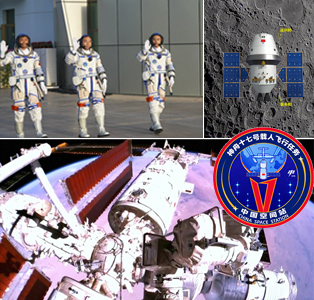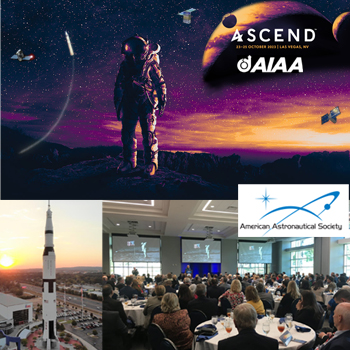China Working to Expand Footprint in LEO and Cislunar Space with Eye on Outer Solar System
|
MONDAY☆ Oct 23 — International Space Station, ~415-km LEO: Expedition 70 crew working with imaging Moon at specific points in lunar cycle to study changes in Earth’s albedo; Jasmin Moghbeli and Loral O’Hara participate in ASCEND conference 12:20 EDT, live coverage available. ☆ Oct 23 — Tiangong Space Station, ~390-km LEO: Shenzhou 16 three-member crew to welcome Shenzhou 17 spacecraft and crew, while preparing for return to Earth after ~5 month mission. Highlights… o NewSpace: Relativity Space to launch multiple payloads for Intelsat NET 2026, bringing booking contracts to US$1.9B; Auriga Space of Long Beach CA developing electromagnetic launch system with $5M investment; Australia-based HEX20 signs MoU with Skyroot of India and ispace of Japan for lunar satellite missions. ☆ Solar System: Volcanic Jupiter moon Io images captured by JunoCam being shared globally; Drawing on NASA, ESA, CNSA and ISRO data, University of Oxford-led study points to tectonic cause of 4.7 quake on Mars; Astronomers Charles Lawrence, Martin Elvis, Sara Seager urge next gen space observatories be built to Starship / New Glenn capacities. ☆ Galaxy: NEOWISE and Las Cumbres Observatory data holds first detection of planeta y collision per University of Bristol study; 4th Gaia data release in 2025 may reveal frequency of Jupiter-like long orbit gas giants as detected in Beta Pictoris Moving Group; Harvard and Smithsonian CfA study calculates dark matter halo around MWG is correlated with skewed galaxy shape. o Global: First China Taikonaut Yang Liwei says lunar mission training underway, Moon will serve as staging ground for deep space exploration; India PM declares intent to build and launch crew to ‘Bharatiya Antariksha’ space station by 2035, land Vyomanaut on Moon by 2040; Mitsubishi plans bimonthly annual launch cadence for H3 medium-lift rocket following inaugural launch NET 2024. ● USA: Blue Origin entering deep space logistics market with Blue Ring craft featuring 3,000-kg payload capacity, to launch NET 2025; UC Berkeley plans $2B, 36-acre space center adjacent to NASA Ames; Commercial space leaders call for increased FAA funding and extension of moratorium on human spaceflight regulation. ● Hawai’i: IfA astronomers developing 4MP HgCdTe infrared sensors for 6-m Habitable Exoplanet Observatory with Leonardo, Markury Scientific, and Hawaii Aerospace under $4M NASA grant; West Hawaii Today columnist recounts Dec 2020 UAP encounter as DoD confirms 800+ cases under review by All-Domain Anomaly Resolution Office. |
 |
● = Terrestrial and… o = International terrestrial events
☾ = Moon activity ★ = Space and… ☆ = International space / astro events in Hawaii Standard Time unless noted. Add 10 hours to obtain UT (‘Universal Time’). |
Weekly Planet Watch – Evening Planets: Venus (E), Jupiter (E), Saturn (SE), Uranus (E), Neptune (SE). Morning Planets: Mercury (E).
ASCEND and von Braun Gatherings Boost Lunar, Deep Space Future Vision |
o Oct 23-24 — Arose, Curtain University, University of Western Australia, Fugro SpAARC, Gvnt of Western Australia, Perth, Australia: Indo-Pacific Space & Earth Conference 2023. ● Oct 23-25 — AIAA, Lockheed Martin, JPL, Northrop Grumman, Boeing, ULA, Hybrid / Las Vegas NV and Online: 2023 ASCEND (Accelerating Space Commerce, Exploration, and New Discovery). ● Oct 23-27— Caltech-IPAC, MIT, University of Wisconsin, Côte d’Azur Observatory, University of Sheffield, Gemini Observatory, et al, Pasadena CA: Surveying the Milky Way: The Universe in Our Own Backyard. ☆ Oct 23 — Apollo Asteroid 2023 TV4: Near-Earth Flyby (0.013 AU). ☆ Oct 23 — Apollo Asteroid 2023 TC6: Near-Earth Flyby (0.034 AU). Ongoing… ☾ Sep 6 – NET Jan/March — Smart Lander for Investigating Moon (SLIM), Lunar Landing Trajectory: SLIM Moon mission 4-6 month trajectory to soft land east of Shioli crater (13.2°S, 25.2°E) on Moon near side equatorial region. ☆ Sep 6 – NET Mar — X-Ray Imaging and Spectroscopy Mission (XRISM), ~550-km LEO: XRISM undergoing 6 month check out testing phase before start of science operations to study galactic plasma. ★ NET Q4 — ULA, Launch Vulcan Centaur / Astrobotic Peregrine Lander, SLC-41, Cape Canaveral SFS FL: Astrobotic Peregrine lander to attempt to touchdown near Gruithuisen Domes, with 14 NASA payloads for Artemis Program, CMU Iris Lunar Rover, total 90 kgs of customer payloads from commercial companies and international space agencies, institutions. TUESDAY★ Oct 24 — Mars Odyssey, Mars Orbit: NASA spacecraft reaches 22 full years / begins 23rd year in orbit around Mars today, holds record for longest-surviving continually active spacecraft in orbit around a planet other than Earth; launched 2001. Oct 24-26 — Aix-Marseille University, Johns Hopkins APL, JPL, Aix-en-Provence, France: Workshop on the Origins and Habitability of the Galilean Moons. ☾ Oct 24 — Moon: 2.57° SE of Saturn, 01:00. ☆ Oct 24 — Aten Asteroid 2023 TX8: Near-Earth Flyby (0.008 AU). ☆ Oct 24 — Aten Asteroid 2019 HH4: Near-Earth Flyby (0.033 AU). |
WEDNESDAY
☆ Oct 25 — International Space Station, Expedition 70 / Russia EVA #61, ~415-km LEO: Two members of Expedition 70 to perform ~6.5-hour spacewalk to install a synthetic radar communications system, deploy a solar sail technology satellite and replace electrical connector patch panels; starts 16:20 EDT, live coverage available.
● Oct 25-27 — American Astronautical Society, Huntsville AL: 16th Annual Wernher von Braun Symposium 2023: From LEO to Lunar and Beyond; at University of Alabama in Huntsville.
☾ Oct 25 — Moon: 1.36° SE of Neptune, 17:00; at perigee (distance 364,894 km), 17:03.
☆ Oct 25 — Aten Asteroid 2023 SO11: Near-Earth Flyby (0.008 AU).
THURSDAY
☆ Oct 26 — CNSA, Launch Long March 2F / Shenzhou 17, Jiuquan Satellite Launch Center, China: Three-member crew of Shenzhou 17 set to launch to Tiangong Space Station, overlap with Shenzhou 16 crew for ~5 days.
★ Oct 26 — STEREO (Solar Terrestrial Relations Observatory) A & B, Heliocentric Orbit: NASA craft imaging Sun and solar phenomena reach 17 full years / enter 18th year in space today, launched 2006.
● Oct 26 — NASA Science Mission Directorate (SMD), Online / Washington DC: Entrepreneurs Challenge; round 2 submission deadline.
● Oct 26 — Pacific International Space Center for Exploration Systems (PISCES), Online / Hilo HI: Space Science Symposium Talks: Building Satellites for Remote Sensing in Hawaiʻi; featuring Aerospace Engineer Amber Imai-Hong discussing small satellite missions through HIGP and HSFL.
● Oct 26 — Secure World Foundation, Online / Washington DC: A Vibe Check on Space Security Diplomacy; 11:00-12:30 EDT.
☆ Oct 26 — Apollo Asteroid 2023 TG14: Near-Earth Flyby (0.010 AU).
FRIDAY
● Oct 27-28 — JHU / APL, NASA, SwRI, Hybrid / Brookline MA and Online: New Horizons Open Science Meeting #54.
● Oct 27-28 — National Space Society (NSS), Phoenix AZ: 2023 Space Settlement Summit.
SATURDAY
☾ Oct 28 — Moon: Full Hunter’s Moon, 10:23; 2.89° NNW of Jupiter, 21:00.
☾ Oct 28 — Partial Eclipse of the Moon: Visible from everywhere on the night side of the Earth; partial eclipse begins 09:35:25, maximum 10:14:05, partial ends 10:52:40 HST.
SUNDAY
● Oct 29 — The Space Show, Online / Las Vegas NV: Dr. David Livingston hosts CEO and President of Ecliptic Enterprises Corporation Rex Ridenoure.
o Oct 29 — Standard Time (Europe): Change clocks back 1 hour, from Summer Time to Standard Time.
☾ Oct 29 — Moon: 2.70° NNW of Uranus, 15:00.
☆ Oct 29 — Mercury: 0.33° SSW of Mars, 04:00.
☆ Oct 29 — Apollo Asteroid 2023 UA2: Near-Earth Flyby (0.033 AU).

